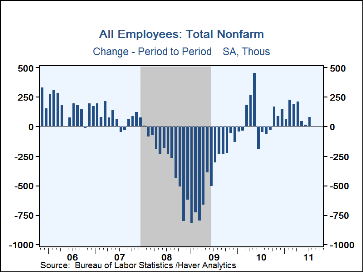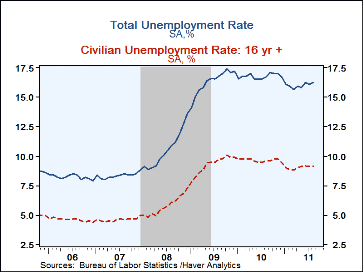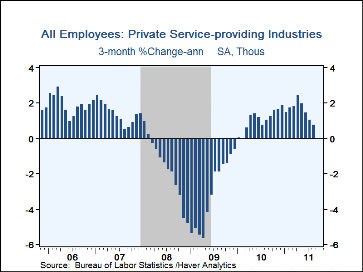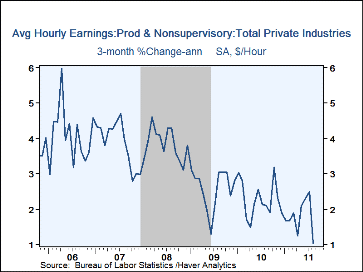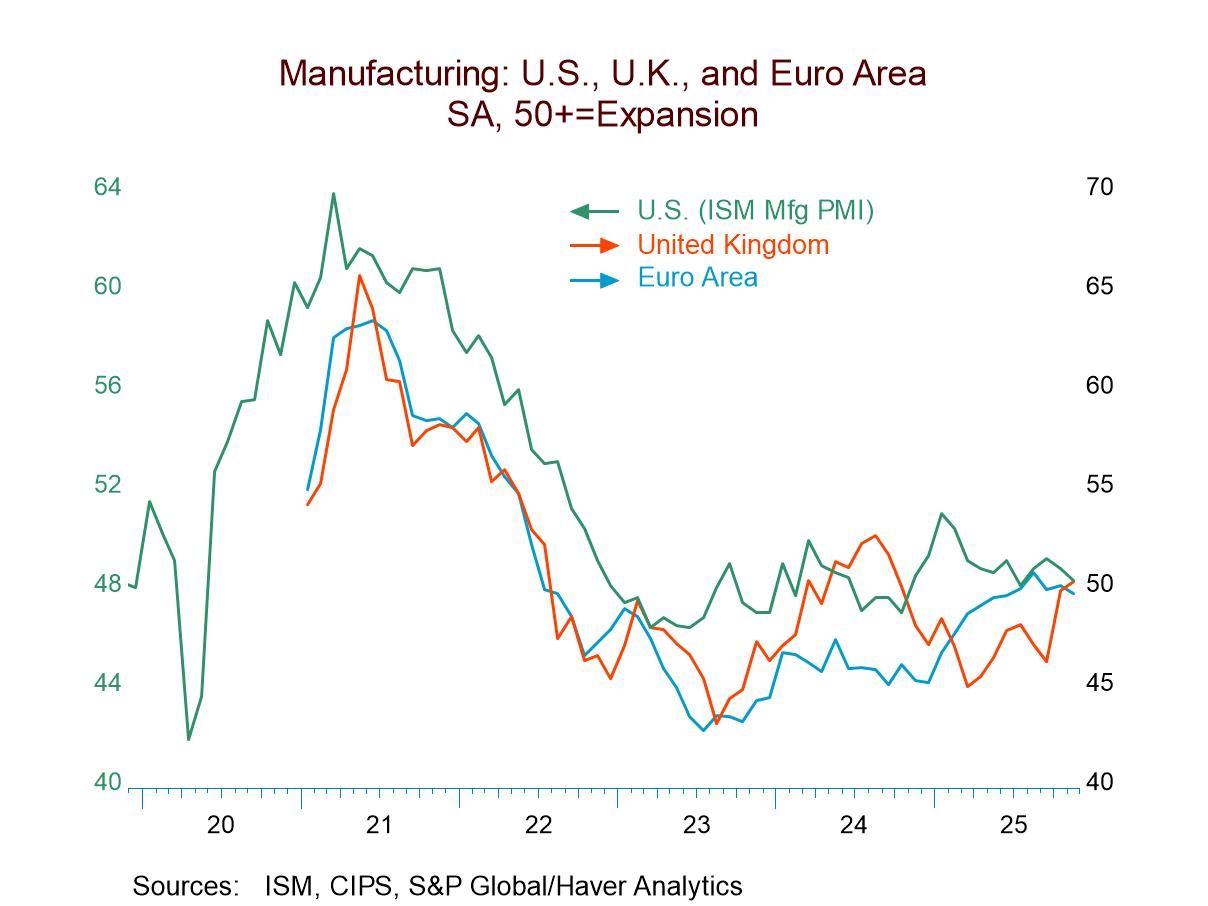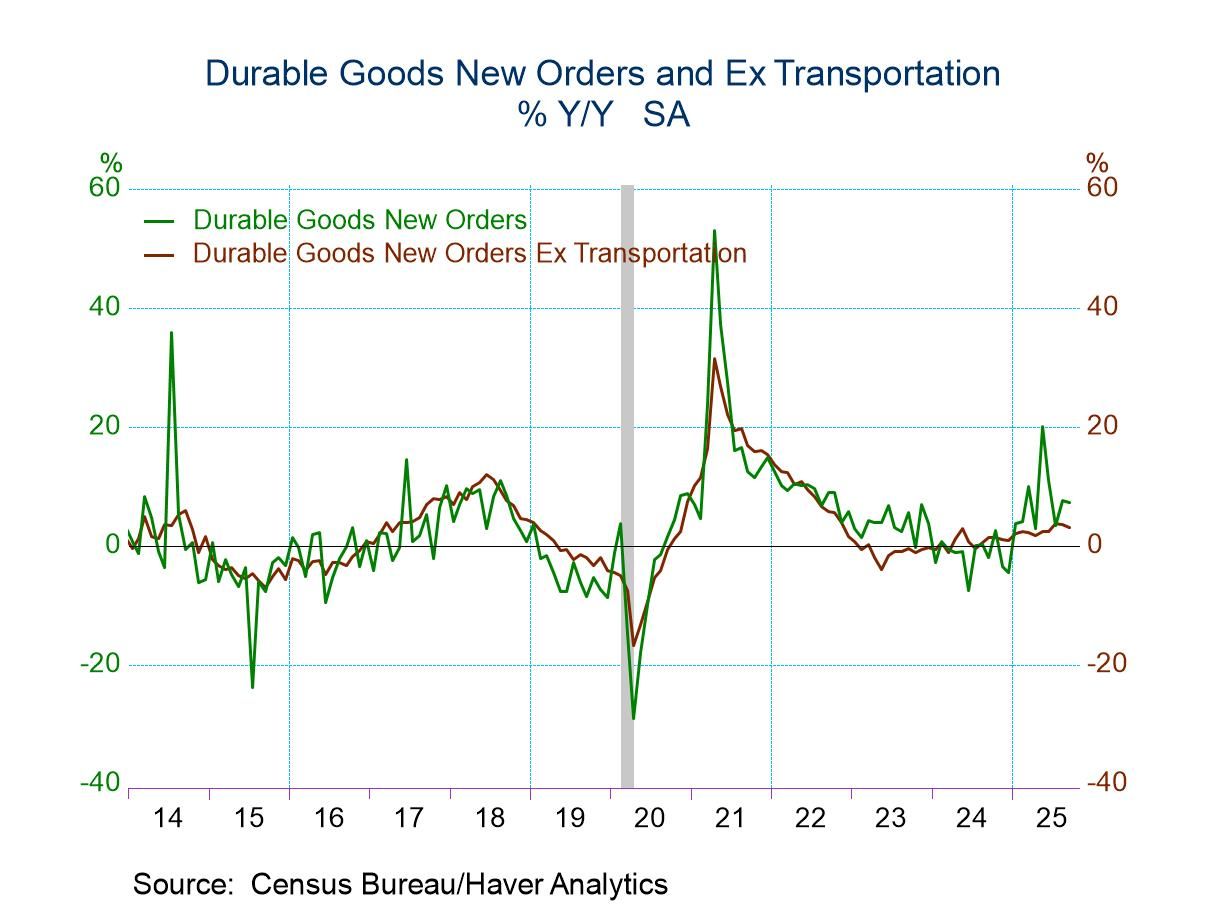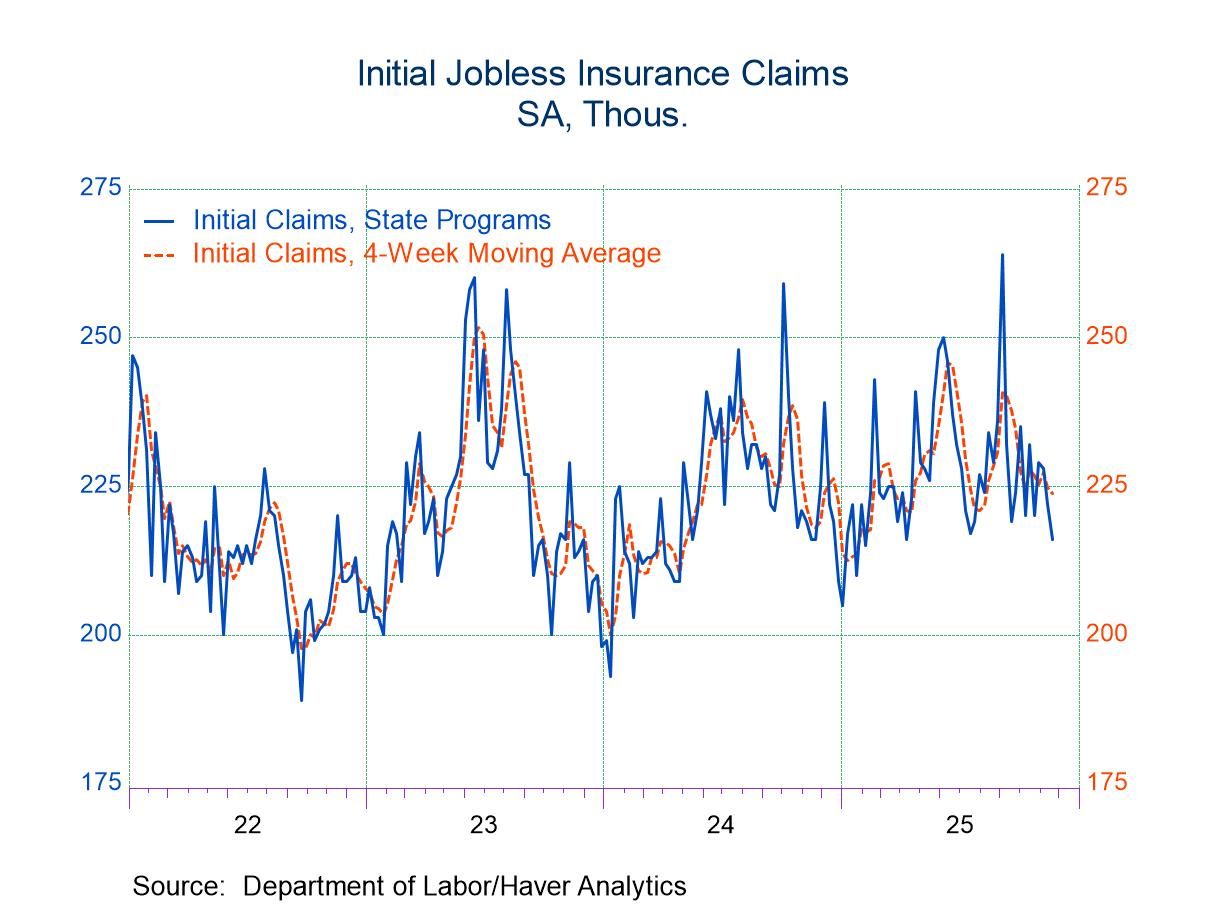 Global| Sep 02 2011
Global| Sep 02 2011U.S. Nonfarm Payrolls Are Depressed & Weak
by:Tom Moeller
|in:Economy in Brief
Summary
The job market showed no glimmer of improvement last month, held back by a strike, lower factory sector employment and lower earnings. An unchanged reading for nonfarm payrolls followed downward revisions to earlier numbers and [...]
The job market showed no glimmer of improvement last month, held back by a strike, lower factory sector employment and lower earnings. An unchanged reading for nonfarm payrolls followed downward revisions to earlier numbers and compared to expectations for a 93,000 rise. The unchanged unemployment rate of 9.1% was expected.
Nonfarm payrolls were unchanged last
month following gains of 85,000 and 20,000 during July and June, revised
from 117,000 and 46,000 respectively. The reading reflected a strike at
Verizon, but weakness spread throughout the jobs categories. Factory
sector payrolls fell 3,000 due to declines in motor vehicles, furniture,
food & textiles. The 5,000 worker decline in construction employment
left the y/y change at just 0.1%. In the service sector, the measly 20,000
worker increase reflected widespread weakness. Information businesses shed
48,000 jobs (-30% y/y) led by the strike but there were declines
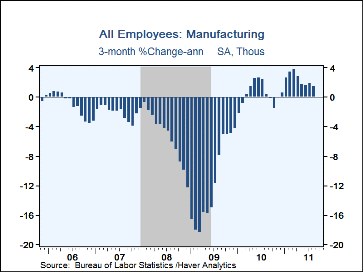 elsewhere. Retail trade jobs fell by 22,200 (+1.1% y/y) and amongst
transportation & warehousing businesses, jobs fell slightly for the
second consecutive month. In the government sector, jobs fell again led
down by 20,000 fewer (-2.0% y/y) state & local gov't workers. To the
upside, professional & business service employment rose a stable
28,000 (3.0% y/y) while jobs in health care & social assistance gained
35,500 (2.2% y/y). Temporary help jobs rose 4,000 (7.2% y/y) while leisure
& hospitality jobs inched up just 2,000 (1.3% y/y).
elsewhere. Retail trade jobs fell by 22,200 (+1.1% y/y) and amongst
transportation & warehousing businesses, jobs fell slightly for the
second consecutive month. In the government sector, jobs fell again led
down by 20,000 fewer (-2.0% y/y) state & local gov't workers. To the
upside, professional & business service employment rose a stable
28,000 (3.0% y/y) while jobs in health care & social assistance gained
35,500 (2.2% y/y). Temporary help jobs rose 4,000 (7.2% y/y) while leisure
& hospitality jobs inched up just 2,000 (1.3% y/y).
Elsewhere in the establishment survey, average weekly worked slipped to 34.2, the lowest level since January. Along with the jobs weakness, this decline left the index of aggregate hours worked & payrolls down slightly from Q2 after that quarter's 0.9% rise.
Adding to the notion of a weak jobs report was a 0.1% slip in average hourly earnings. The decline was the first since December and pulled the y/y gain down to 1.8%. Earnings in the service sector fell m/m (+1.7% y/y) and factory sector earnings slipped as well (+1.8% y/y).
From the household survey, the unemployment rate held constant at 9.1%. That reflected a 331,000 increase (0.3% y/y) in employment and a 366,000 rise (-0.3% y/y) in the labor force. The overall unemployment rate, including involuntarily part-time workers as well as those marginally attached, ticked up to 16.2%. The labor force participation rate ticked up m/m but at 64.0% was near its lowest since 1984. The number of workers unemployed for 52 weeks or longer slipped m/m to 4.458M (+0.7% y/y) but remained near its high. The average duration of unemployment remained near its high at 40.3 weeks.
The figures referenced above are available in Haver's USECON database. Additional detail can be found in the LABOR and in the EMPL databases. The expectation figures are from Action Economics and are in the AS1REPNA database.
| Employment: (M/M Chg., 000s) | Aug | Jul | Jun | Y/Y | 2010 | 2009 | 2008 |
|---|---|---|---|---|---|---|---|
| Payroll Employment | 0 | 85 | 20 | 1.0% | -0.7% | -4.4% | -0.6% |
| Previous | -- | 117 | 46 | -- | -- | -- | -- |
| Manufacturing | -3 | 36 | 14 | 1.8 | -2.7 | -11.6 | -3.4 |
| Construction | -5 | 7 | -7 | 0.1 | -8.1 | -16.0 | -6.1 |
| Private Service Producing | 20 | 104 | 59 | 1.6 | -0.1 | -3.5 | -0.2 |
| Government | -17 | -71 | -55 | -2.0 | -0.3 | 0.3 | 1.3 |
| Average Weekly Hours | 34.2 | 34.3 | 34.3 | 34.2 (Aug.'10) |
34.1 | 33.9 | 34.5 |
| Average Hourly Earnings (%) | -0.1 | 0.3 | 0.1 | 1.8 | 2.4 | 3.0 | 3.8 |
| Unemployment Rate(%) | 9.1 | 9.1 | 9.2 | 9.6 (Aug.'10) |
9.6 | 9.3 | 5.8 |
Tom Moeller
AuthorMore in Author Profile »Prior to joining Haver Analytics in 2000, Mr. Moeller worked as the Economist at Chancellor Capital Management from 1985 to 1999. There, he developed comprehensive economic forecasts and interpreted economic data for equity and fixed income portfolio managers. Also at Chancellor, Mr. Moeller worked as an equity analyst and was responsible for researching and rating companies in the economically sensitive automobile and housing industries for investment in Chancellor’s equity portfolio. Prior to joining Chancellor, Mr. Moeller was an Economist at Citibank from 1979 to 1984. He also analyzed pricing behavior in the metals industry for the Council on Wage and Price Stability in Washington, D.C. In 1999, Mr. Moeller received the award for most accurate forecast from the Forecasters' Club of New York. From 1990 to 1992 he was President of the New York Association for Business Economists. Mr. Moeller earned an M.B.A. in Finance from Fordham University, where he graduated in 1987. He holds a Bachelor of Arts in Economics from George Washington University.


